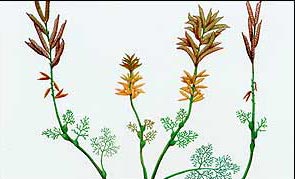Angiosperms Downsized Their Genomes
Recently, Everything Dinosaur published an article on the remarkable discovery of Lepidoptera wing scales in Upper Triassic/Early Jurassic drill cores from Germany. This fossil evidence suggested that butterflies and moths were around some 200 million years ago. This raised the question, what did the adult insects feed on? Butterflies and moths are closely associated with feeding on the nectar produced by flowering plants (angiosperms), this led to speculation that, as some scientists have already suggested, flowering plants evolved much earlier than previously thought.
A Water Lily in Flower (Angiosperm)

Picture credit: Everything Dinosaur
Whenever the flowering plants (angiosperms) evolved, they seem to have out-competed other types of plants such as gymnosperms, pteridosperms and the very ancient Lycopodiophyta, for example. How did they do this? After all, they are the most diverse of all the land plants with something like 300,000 species. Scientists from San Francisco State University and Yale, writing in the academic journal PLoS – Biology, propose that a downsizing in the plant’s genome is the key to their success.
Thinking Smaller
Current thinking is that the angiosperms, radiated and diversified very rapidly, becoming the dominant terrestrial vegetation by the Late Cretaceous. Flowering plants took over the world, leading to the astonishing variety of plants we find today. The scientists conclude that at a critical point in the evolution of the angiosperms, they downsized their genomes.
Flowering plants reduced the amount of DNA held within the nucleus of each cell, this permitted these plants to make smaller cells and to build leaves with more sophisticated and complicated structures, of great assistance when it comes to improving the efficiency of photosynthesis, along with the use of energy and the management of each cell body. This reduction in the genome, is likely to have given angiosperms a competitive advantage over other types of plants.
Co-author of the study, Assistant Professor of Biology (San Francisco State University), Kevin Simonin explained:
“Flowering plants are the most important group of plants on Earth, and now we finally know why they’ve been so successful.”
The Rise of Flowers Puzzles Darwin
Prior to the evolution of the angiosperms, terrestrial vegetation was dominated by ferns, horsetails, clubmosses, cycads and their relatives along with conifers. Flowering plants took over and make up more than 90 percent of all the land plant species around today. Even Charles Darwin was perplexed by the success of the angiosperms and scientists ever since have been offering potential reasons for it, ranging from the influence of pollinators (such as those ancient butterflies and moths referred to earlier), to a reshuffling of genes. What has been missing is an explanation of just how flowering plants became so successful in the first place.
Flowering Plants in the Cretaceous
Picture credit: Richard Bizley
Working in collaboration with Adam Roddy (Yale University), Assistant Professor Simonin, undertook a review of the current literature and demonstrated that flowering plants went through a dramatic genome downsizing as they evolved. In comparison, the genomes of other plants, competing with flowers remain relatively unchanged. Smaller genomes means the option to make smaller cells, with those smaller building blocks, the team showed, flowering plants can construct more complicated networks of veins to keep their cells hydrated and more pores (stomata) in their leaves to draw in the carbon dioxide they need to make food. More stomata, permitted more efficient gaseous exchange, both oxygen and CO2.
Finer Genomes Make Finer Flowering Plants
The researchers mapped the genome downsizing patterns they had identified and applied a phylogenetic assessment to their data. They discovered that flowering plants began to downsize their genomes at around the time they were beginning to dominate terrestrial flora. According to this study, having a greater variety of cellular building blocks apparently gave flowering plants an edge over conifers and other types of plant. It is not only the flowering plants that have benefited, pollinators have also become more successful and much of the food that we consume and that we feed to domestic animals comes from angiosperms.
The idea to investigate the size of the genome of flowering plants, came indirectly from one of Assistant Professor Simonin’s students. During a lecture, the student enquired whether whales had big genomes? Simonin began to think more about the size of cellular genetic material and its impact on plant physiology.
An Illustration of Prehistoric Flowers – Archaefructus
Picture credit: Associated Press
He explained:
“It sent me down this whole path of genome-size research. It reinvented the research in my lab in many ways.”
On-going Research
Research is continuing in this field of botany. San Francisco State University scientists in conjunction with colleagues from other academic bodies are currently exploring some groups of flowering plants that don’t seem to have reduced their genomes. In certain environments, perhaps where photosynthesis is more difficult, there might not be a competitive advantage to be gained. There might be no evolutionary pressure for plants to create smaller cells. This new study, has shed some much needed light on a puzzle that Charles Darwin referred to as “an abominable mystery”
To read about the research into Late Triassic/Early Jurassic Lepidoptera: Ancient Butterflies Flutter By.
Everything Dinosaur acknowledges the help of the San Francisco State University in the compilation of this article.
Visit the Everything Dinosaur website: Everything Dinosaur.








Leave A Comment